Originally compiled by Clarrie Neal February 2000.
Updated in June, 2009.
The following article was printed in Rugby League Week in July, 1977.
“Riverstone is a peaceful, sleepy little town lying at the foot of the famous Blue Mountains, 56 km west of Sydney. The Riverstone club was born during one of the most turbulent times in world history. As World War 1 broke out the Riverstone Butchers, as they became known, got off to a modest beginning, but no one knows exactly when the club was formed. The clubs records only go back to 1915 , but some claim the club was formed shortly before World War, others argue it was as early as 1911.”
The Windsor & Richmond Gazette has been continually printed since 1886 and has proved to be an excellent source of reference for resourcing the history of the Riverstone Football Club. It records that several attempts were made to form a Football Club in Riverstone in the years 1891 and 1894. As there were no organised competitions it is likely these matches would have been of a social nature against neighbouring towns. Also, it should be noted that as Rugby League was not officially played until 1908, it is likely these early efforts to form a club would probably have been to the Rugby Union code.
1891/5/6th – 20 members held a meeting in J. Irelands Riverstone Hotel to form a football club. Later that year it noted the ground was pegged out and goal posts erected.
1894/5/25th – A meeting was held to form a football club and 2 teams were selected to play a trial game. Football practice commenced on the newly formed ground in Mr. B. Richards paddock on Tuesday. It is interesting to note that each team comprises 13 players; which indicates the 13 a side game was being played unofficially many years before the official date of 1908.
Tom Woodfield’s team – W. Baxter, B. Bell, F. Cornwell, H. Smith, J. Rosa, Jersey, J. Brown, W. Hodge, H. Campbell, W. Warden, H. Parrington, F. Marlin, C. Miles.
Arthur Cornwell’s team – J. Little, C. Stanford, C. Drayton, G. Varidel, F. Rosa, W. Small, H.Sunley, M. Parmenter, W. Henley, J. Melville, W. Forbes, H. Spinks, J. Viney.
Umpires – R. Toomey, H. Spinks, W. J. East.
In 1897, attempts were made to form a football club but apart from a couple of trial games played they were unsuccessful.
The W. & R. Gazette on the 28th April 1900 noted that 22 members held a meeting to form the Riverstone Football Club and the following committee was elected:
Patron – Mr. B. Richards, President – J. Quinn, Vice Presidents – B.Hall, J.Cragg, E. Bradley, F. Mette, C. Davis, L.J. Darling, A. Bambridge. Treasurer – A. Jarrett.
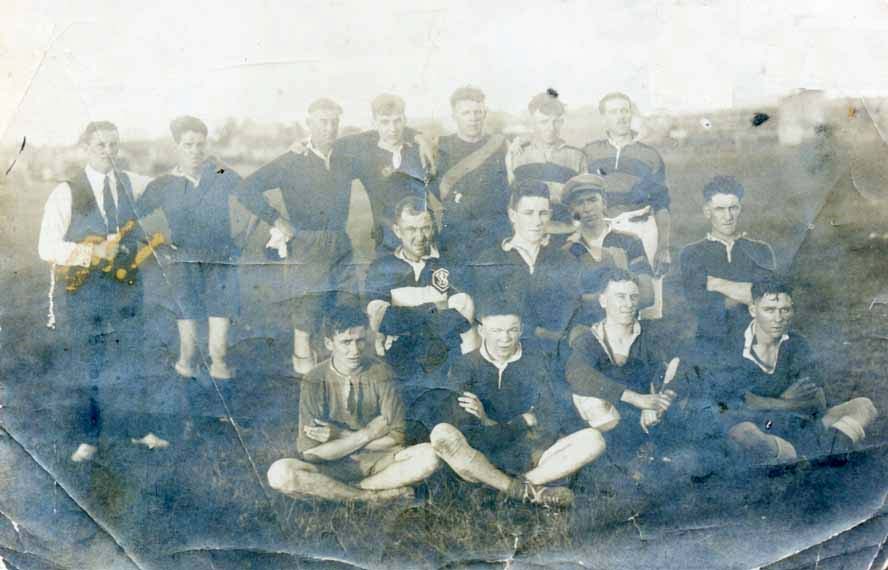
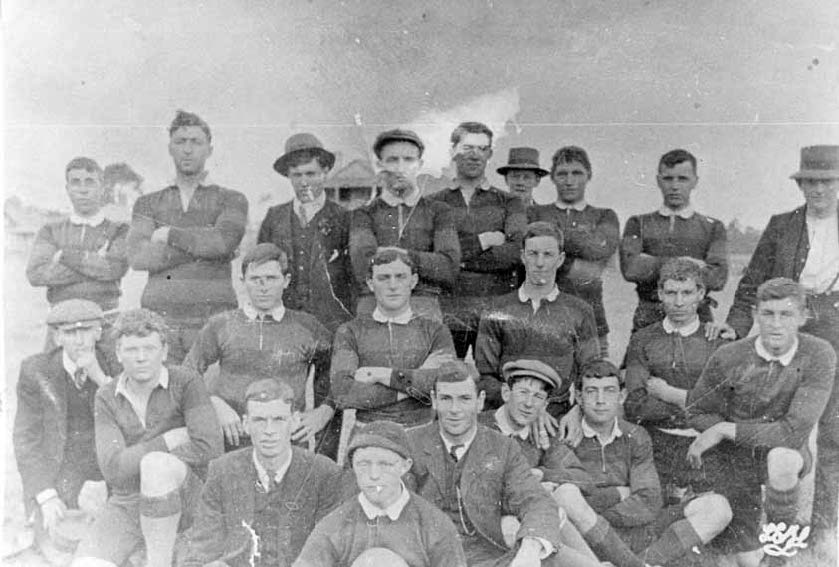
It was decided the club colours would be Blue, Black and Gold in 2-inch bars. After a promising start no match results appeared in the Gazette so it is likely that the club failed to survive.
It was 1907 before match results again appeared in the Gazette when, Riverstone played 2 social games against Windsor and another against Glebe Island.
The Gazette reported a greater interest in 1910 when the Riverstone Football Club was formed and several matches were played against teams from Auburn, Windsor, Glebe Island and Seven Hills. However, there is no record of these games being part of an official competition.
The Gazette noted the results of several of these matches:
1910/5/21 – Riverstone Football Club were defeated by Windsor 15 – 0 at Riverstone.
1910/5/28 – Riverstone defeated Windsor Athletic Club 11 – 3.
1910/6/11 – Riverstone defeated a team from Auburn 8 – 3, the best player was S. Drayton.
1910/6/25 – Riverstone defeated a combined Windsor Rovers/Athletic team 11 – 3 at Windsor. The best players were H. Davis, C. Davis, & T. Woolfe.
After this match, Mr. Pomfret, a great supporter of the Riverstone club invited the players to his home to celebrate. In a speech he said he felt proud to be a member of the Riverstone Football Club.
1910/7/2 – The Gazette reported- “A great match is to take place in Riverstone this Saturday between the Windsor Football Club and the best blood of Riverstone. Never in the history of Riverstone has such excitement prevailed in football circles. Old timers have their sons representing them, men such as Mills, the famous three-quarter from the Surrey club, and Stan Wall, the fast sprinter, will play for Windsor. In the evening a banquet will be tendered to the victorious team by the vanquished side. Ald. J Cragg will represent Windsor at the function, and Mr W Weymark will preside at the gathering for Riverstone. On Wednesday evening a presentation will be tendered to Joe Brown for the able manner he has coached the Riverstone Club, thus securing victories against older and more experienced teams.
Ald. J M Cragg will be asked to make the presentation on behalf of the Riverstone folk, and all true sportsmen are invited to attend the club rooms of the Riverstone Hotel next Wednesday at 3-30 pm.”
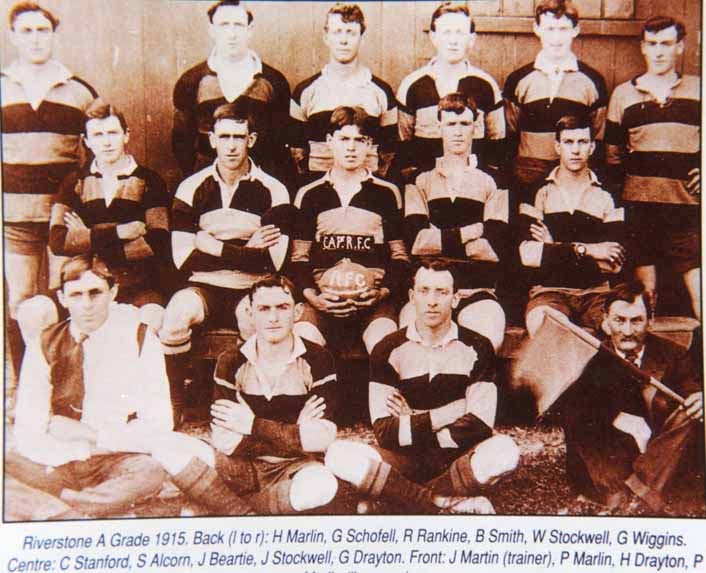
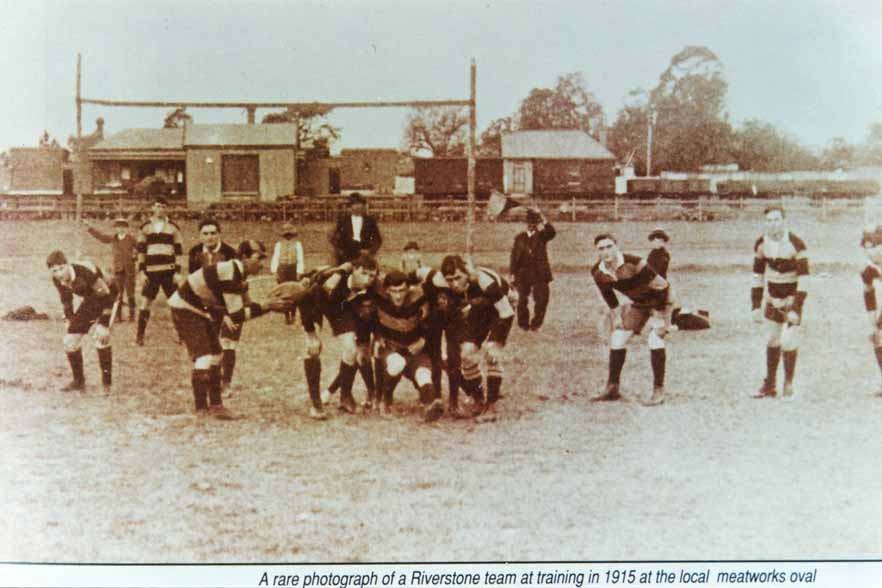
1910/7/9 – The match was won by Windsor, easily defeating Riverstone 17 – 0. In speeches made at the dinner after the game, Mr Weymark, the Riverstone Secretary congratulated the Windsor team on their win. Stan Wall spoke for the winners, hoping Rivo would play a return match at Windsor for a turkey dinner. (as supposedly arranged this time), and not corned beef. The referee Mr O’Callaghan then instructed both teams, and said Riverstone players had much to learn.
These comments on the dinner by Stan Wall sparked a war of words between the 2 correspondents over the coming weeks, with several letters to the editor.
1910/7/16 – The Riverstone secretary responded to the Windsor claims of a turkey dinner, stating it was never a turkey dinner, it was for a roast dinner at a cost of 1 shilling, the vanquished players having to pay 2 shillings each. He then commented on the Windsor boys behaving in a rowdy fashion, breaking a table in halves, and acting like a lot of goats. He further commented the dinner at Riverstone was better than the bread and cheese they had received on their visit to Windsor.
1910/7/23 – The Windsor correspondent replied but remained anonymous under the name “Who’s this”. He criticised the dinner again and then made several comments on the behaviour of the Riverstone boys, and asked why his report could be false when Windsor won so easily.
1910/7/30 – W. Weymark this time asks who would expect a turkey dinner for a shilling, and offers 5 pounds to Windsor Hospital if it can be proved that such an agreement existed. He then invited ‘Who’s this’ to come out into the open.
This letter marked the end of the war between the football correspondents.
1910/10/3 – “The Riverstone Football Club will hold their annual picnic at an early date, and in the evening a dance will be held. Mr. Harry Smith will take the opportunity by presenting the best player during the season with a handsome trophy, which is now on view at the Riverstone Hotel. Thanks are due to Mr. Smith.”
However the interest shown in 1910 was short lived as in the following years, 1911-12 -13, only an occasional social match was played.
1914 saw a growing interest in the new code of Rugby League and several matches were played. The Gazette noted that several matches were played against teams from Windsor, Richmond, and North Parramatta.
1914/8/28 In a game played at Riverstone, the home team were leading Windsor by 12 points to 4 when the game was called off. The Gazette noted –
“The football ground at Riverstone on Saturday was evidently converted into a slaughter yard. A Windsor District Club team went down to play Riverstone and the game had proceeded right enough until the scores were Riverstone 12 and Windsor 4. Then the football field was converted into a battlefield. We are told 30 to 40 persons were engaging in a free fight. Arms and legs were flying indiscriminately in the air, and any face or body within reach was hit and kicked ad lib. One would have thought the German Army had invaded the town.”
This interest shown in 1914 continued on to 1915 and the Riverstone Club for the first time entered a team in the Western Districts Junior League competition. The Gazette noted –
1915/4/16 – The Football Club was formed and members were training and marking out the playing field.
1915/5/21 – Their first competition match saw Riverstone defeat Blacktown 2-0.
Riverstone then played teams from North Parramatta, Lidcombe, and Springwood, and in July playing at North Parramatta they were defeated 29 – 0. It was noted the boys still came home happy and this was the last reference to the football club for the year. There is no evidence of competition matches being played in 1916.
The club was formed again in April, 1917 and a team was entered in the Western Districts competition with teams from Liverpool, Fairfield, Merrylands, Parramatta, Auburn, Blacktown, Richmond, Emu Plains, Windsor and Riverstone. With rail the only available form of transport, and a poor service on the Richmond Line, getting the teams to their away games was always a problem.
With so many young men at the war front it appears many clubs were struggling to field their teams. On 5th May 1917 the Gazette noted – “ Owing to many of the former members of the Riverstone Football Club being killed at the war during the last few months, the club intends to call a meeting to consider the advisability of abandoning all their matches this season.”
However the club must have decided to continue playing with the Gazette regularly publishing the results and noting on 29th May that Riverstone was in second place on the ladder. The Gazette on 6th July noted that the footballers were helping Pte. J. Fell on his poultry farm after he had returned home wounded from the war. In August the club was fined 7 shillings and sixpence when one of its players advised the referee “he was not refereeing in a fair way”
The competition was in more trouble with the great rail strike that prevented the teams from travelling, Riverstone receiving forfeits from Fairfield, Auburn and Blacktown. The Gazette 24th August reported the competition was abandoned until after the rail strike ended. This was the last time Rugby League was mentioned for the 1917 season and the Gazette makes no mention of competition matches being played in the War years of
1918 or 1919.
The Western Districts Junior R. L. competition re-commenced in 1920 with teams from Parramatta North, Parramatta Endeavours, Granville, Lidcombe, Auburn, Windsor, Wentworthville, Blacktown, St. Marys, Emu Plains, Penrith and Riverstone. The ‘A’ grade was open and the ‘B’ grade under 9 stone 7lbs.
Riverstone entered a team in each grade, with the ‘A’ grade withdrawing from the comp in mid July. Many clubs had problems getting teams to their ‘away’ games, there were no motor vehicles and train travel was the only option. The poor service on the Richmond Line to Riverstone did not help. The ‘B’ grade completed the comp, winning 3 of the 8 games played.
1921 promised to be a much better year for the club with C. Whitehead – Secretary, W. J. East – Patron, D. Doolan – President, and W. Wiggins – Treasurer. The club registered their new colours – black and gold and entered teams in both grades.
The Gazette was now giving a better coverage of the Rugby League code with results of all games and the points table for both grades. It also noted that some teams could now travel by motor lorry. Both teams finished the comp in the bottom half of the ladder, with C. Whitehead being their best player. The Gazette noted the ‘B’ grade game against Blacktown was played in 30-minute halves to allow the visitors the time to catch their train home.
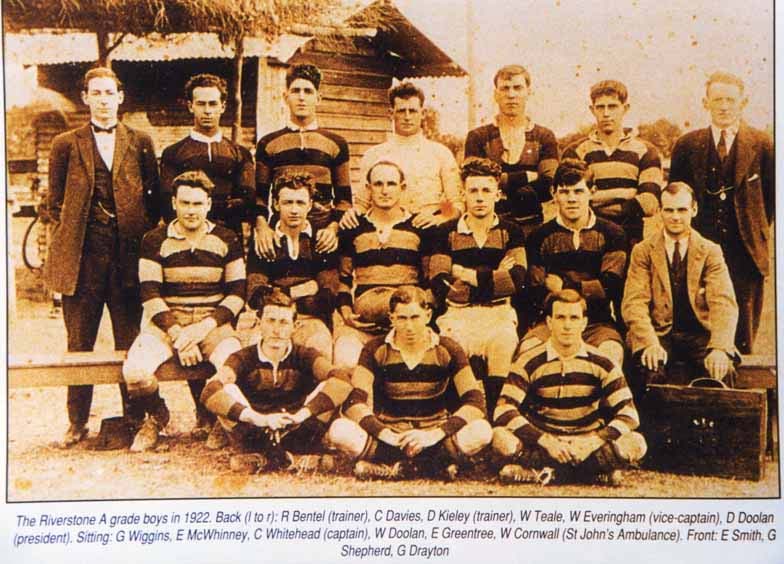
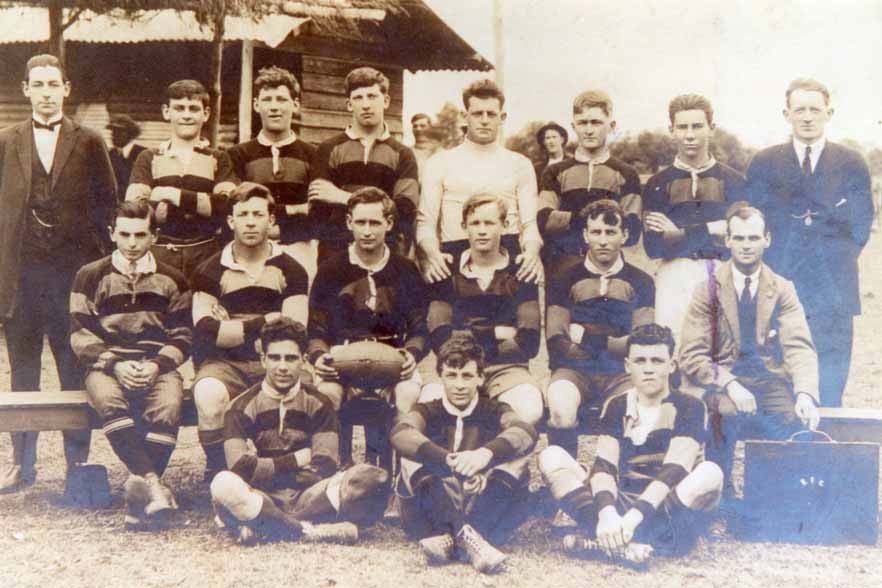
Back row: 1. R Bentel (Trainer) 2. N Rosa 3. S. Mangold 4. S. Alcorn 5. D. Keily (Trainer) 6. J. L. Gilbert 7. R Ward 8. D. Doolan (President)
Centre row: 1. A. Arnott 2. P. Drayton 3. W. Turner (Captain) 4. H. Drake 5. J. Chalker 6. W. Cornwell (St Johns Amb.) Front row: 1. S Unwin 2. G. Rosa 3. D. Rosa
Additional teams playing in the 1922 competition included Parramatta East, Clyde, Richmond and Baulkham Hills, with Riverstone fielding a vastly improved team. The Gazette noted on 25th May – “ —- the magnificent victory by Riverstone over last years premiers Parramatta Norths; a team that during the whole of last season and up to last Saturday had remained unbeaten.”
The Western Districts League sometimes had problems getting referees; when the referee failed to show for the Rivo v. Baulkham Hills match the opposing team captains agreed that local officials could referee their games. Les Clarke (Rivo) was the ‘A’ grade referee and the ‘B’ grade game against Windsor was refereed by George Wiggins (Rivo) in the first half, and the second half by Bill Maisey from Windsor.
The Gazette also reported on a visiting Maori team playing in Sydney, with the curtain raiser game being played between Riverstone Vs Paddington. It also noted several Riverstone boys were playing in the President Cup trials at the time.
The Riverstone club held a Masquerade Ball and presentation night in November and presentations were made to – W. Everingham – the best player, Claude Schofield – the best back, Bill Doolan – the best forward, Dennis Rosa – the most improved.
The Gazette on the 30th March, 1923 published a front page report on the Windsor clubs Annual General Meeting, with the headings “Record Season Reviewed” and “Amalgamation With Riverstone.” This heading was somewhat surprising when one considers the previous encounters between these 2 clubs. The delegates representing Riverstone at this meeting were Col Whitehead, Dan Doolan, A. Keegan, P. Gilbert, W. Hanna, and W. Everingham.
The Riverstone Club had raised the matter the previous year of forming our own group of teams from the Blacktown, Penrith, and Richmond districts, but it failed to gain any support. At this Windsor meeting Col Whitehead spoke of the local teams labouring under the many disadvantages such as sparsity of population, and of the difficulties of getting good coaches to tutor the players. He said teams would have to unite to be a force against the strength of the teams from the Parramatta district.
The meeting actually agreed to the proposal but for one reason or another it never eventuated and that was the only time the term ‘amalgamation’ was ever mentioned. In the 1923 competition Riverstone entered an ‘A’ team and ‘C’ team, with Windsor entering a ‘B’ team and a ‘C’ team.
The Riverstone ‘A’ grade played 16 games, winning 8 and 1 drawn game. The C’ grade team finished at the bottom of the table. At the clubs end of year Presentation Ball gold medals were awarded to-Frank Parkinson – most improved player. Les Clarke – most consistent player. Col Whitehead – the best all round player.
In 1924 and 1925, it appears Riverstone did not field teams in the W D R L competition but there was a ‘B’ grade team from Schofields. The competitions in these years were subject to a large number of protests from the various clubs.
1926 – A poorly organised competition saw the only team Riverstone entered (‘B’ grade) withdraw from the competition in July. Very few of the clubs had access to the telephone and communications between the clubs was poor. A lot of games were won or lost by forfeit.
The Gazette in 1927 gave scant coverage to the Riverstone games and it appears the club fielded a ‘C’ grade team only. However, on the 16/9/1927 the Gazette noted – Riverstone Football Club are on the verge of claiming a most successful season. Invariably they left the field victorious, and were supported by a most energetic committee.
It appears that in each grade there were 2 competitions played during the season, the main competition was the Premiership and it was first past the post, there were no semifinals or finals. Later in the season a Knock-out competition began, open to all teams with the semi-finals and finals played the week-ends after the Premiership had concluded
In the ‘C’ grade grand final at Granville Riverstone defeated Westmead Boys Home 5 points to 2. It was 2 all at full time and 20 minutes extra time was ordered when R. Rosa scored for Riverstone. A. Brookes (scrum half) and A. Britton (full back) proved the outstanding players of the afternoon. This was the only match reported the Gazette reported on for the entire 1927 season, so it is likely this was a Knock-out competition.
1928 saw the Gazette giving good publicity to cricket and tennis, both sports being very popular throughout the Hawkesbury, but very little attention to Rugby League. There were no game results or point score tables published throughout the season.
On the 2nd March it noted 40 members attended the first Riverstone club meeting for the year, but Riverstone was rarely mentioned after that, until the end of the year when it noted the Riverstone ‘B’ grade team finished well up in the competition. The Gazette 21/9/1928 reported Blacktown won the ‘A’ grade premiership and Riverstone won the “A” grade Knock-out Cup final defeating Blacktown 4 – 3 in an entertaining final. Their best players were D. McCarthy, C. Schofield and A. Brookes.
At the presentation held on the 12th April 1929, Secretary Bill Doolan thanked the Riverstone Meat Co for providing the playing field and for their assistance with the pavilion.
With the coming of the motor car and truck, often the football teams travelled to their away games on the back of a table top truck, some times having problems, as the Gazette on the 7th June 1929 noted – “18 members of the Baulkham Hills football team returning home from their match against Richmond were injured when their truck was involved in an accident and ran down an embankment. Parramatta ambulance attended and after treating the injured, 2 players were conveyed to Parramatta Hospital.”
10/5/1929 – The Gazette reported a Granville District team of 13 players comprised 10 players from the Riverstone club. The only other reference to Riverstone was when it played Windsor, Riverstone won the ‘B’ grade and Windsor won the ‘D’ grade. Richmond won both the A grade competitions (20/12/1929.
The Gazette 20/5/1930 noted Riverstone defeated Penrith, the best players being Fred Teale, Mr. Allen, and Mr. Schofield. The same report noted Riverstone the next day played the Western Districts Presidents Cup team in a trial match and were defeated 13 points to 8. Fred Teale scored all Riverstone’s points with 2 tries and a goal.
Gazette 29th August, 1930 Riverstone v Toongabbie “Rafferty Rules were the order at the conclusion of the football match played at the latter’s home ground on Saturday afternoon. The home team won the football match by 10 points to 8 , with Fred Teale scoring 2 tries for the losers, but the subsequent battle resulted in Riverstone emerging Victorious ! Fists and feet flew in all directions, so much so that anyone one could have a whack. During the onslaught, it is reported that Riverstone’s popular mascot was rendered ‘hors de combat’ by a blow below the belt!
It was Riverstone’s first defeat on the football field, but they will win the match on a protest. The Gazette 7/ 11 / 1930 congratulated Riverstone on winning the A grade Premiership.
1931 saw Riverstone enter an ‘A’ grade team and a points score table at the 20th June showed Riverstone 3 points behind the leader with a game in hand. The ‘A’ grade points table was published courtesy of a Mr W Kerr of Blacktown; Blacktown 12 points, Toongabbie 10, Penrith 10, Riverstone 9, Richmond 4, Windsor 4, Wenty 2, Wallacia 1.
24 / 7/ 1931 The Gazette reported the Age Limit Rule was becoming a farce — “A” grade football in the country will die out if the ban against a player over the age of 24 is not cut out.
5 /6 / 1931 – R Douglass and F Teale were selected in the WDJRL Presidents Cup team to play the curtain raiser to the NSW – Queensland clash. The Riverstone team to play Springwood next week was also shown, a very rare occasion for the Riverstone team to be named before the game.
The team selected was – A. Britton, K. McDonald, M. Smith, J. Smith, K. Sutton, S. Cummins, L. Locke Capt, C. Douglass. F. Teale, R. Allen, E. Allen, B. Allen, J. Fitzgerald, A. Groves, S. Lane. The truck was to depart Conways shop at 11- am 14th July 1931- The Gazette on the 14th July reported that Riverstone was leading the competition. Fred Teale appeared to be their best player and had been selected in the Western Districts President Cup team. The Gazette reported on protests that were regularly entered by the clubs and the Riverstone Club had recently won several protests. The Gazette was now giving a much better coverage of the Rugby league competition, and other related issues.
7 / 8/ 1931 it reported Windsor had played a social game on their home ground, McQuade Park, the previous Sunday against a team from Pyrmont, their players and supporters arriving in a convoy of 8 tabletop lorries. After the game the police arrived and took the names of all the players, both locals and the visitors, with a view to prosecution for playing sport on the Sabbath.
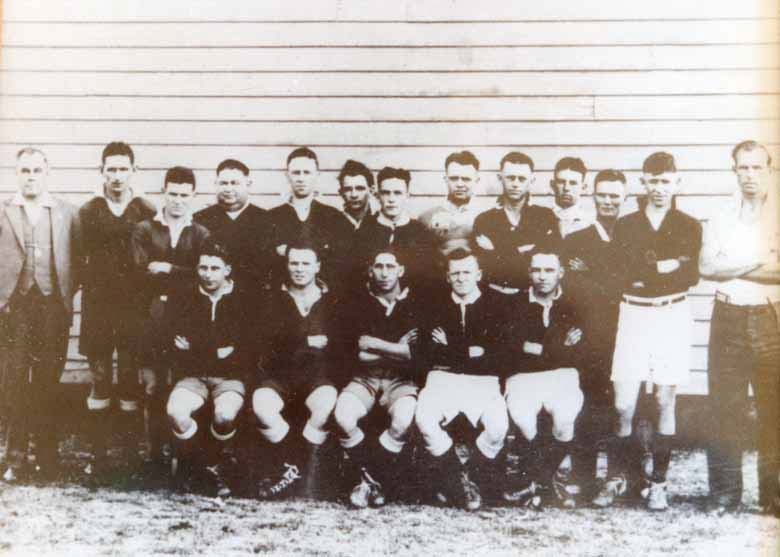
Back Row: 1. Manager M. Johnston 2. Les Britton 3. B. Allen 4. Ben Hibbert 5. Bernie Rosa 6. 7. C. McDonald 8. ‘Bull’ Greentree 9. 10. 11. Ron Allen 12. Jack Freeman 13. Harry Davis
Front row: 1. Tom Johnston 2. Fred Teale ? 3. ‘Tiger’ Locke 4. Sam Lane 5. J. Smith
The Gazette on the 14 / 8 / 1931 on a front page report under the headings – “Windsor Council refuses to take action against footballers “”Sunday Sport is an Important Issue”. The end of the article noted that the Police had dropped all charges.
Also on the same date it noted Riverstone won several protests against other clubs and were now leading the competition by 3 points and have the premiership safely in their keeping 21 / 8 /1931 It noted a WDJRL district team comprising 6 players from the Riverstone club had defeated Western Suburbs 19 -5.
11 /9/1931 Riverstone defeated Toongabbie 11 points to 10 in a semi-final of the Knock-out competition. The following week they defeated Richmond 10 points to 0 in the final thus achieving both championships, the Premiership and the Cup. The club intended to hold a Victory celebration in the Olympia theatre.
In the 1932 competition, Riverstone again fielded a strong team and 4 players were selected in the WDJRL Presidents Cup team – F. Teale, Curly Douglas, Mick Smith and R Lane.
It was another good year for Riverstone with the club winning both the A grade premiership and the Knock-out Cup again. The Gazette 19th August reported Riverstone had won the Premiership when they defeated Penrith 11- 0 at Riverstone, watched by a crowd of almost 1,000 spectators.
Riverstone won the Knock-out cup by defeating Wentworthville 16-3 in the semi-final and went on to defeat Blacktown in the final. The Gazette reported the final as the hardest and fastest game of the season, the score was 8 all at full time, and after 20 minutes extra time, Riverstone emerged the victors 11 – 8. Both teams finished with 11 players, Riverstone lost Curly Douglas when he was carried off, and Arthur Britton was sent off.
In other games after the competition ended, Riverstone issued a challenge to Gosford for the Cusick – Speers Cup. The Gosford paper reported “a spectacular game that thrilled the crowd ended in a 13 all draw”. Riverstone also entered a team in the Lackersteen Cup , but were beaten 12 – nil by Penrith.
Riverstone commenced the 1933 competition well but faded towards the end of the competition. On the 19th May, with a crowd of 700 watching, Blacktown defeated Riverstone 11 – 3. After the game several spectators were involved in a brawl.
The only other references to the club this year was to individuals – 14th July, ‘Tiger’ Locke was called up to play 3rd grade with Western Suburbs, and ‘Mick’ Smith was called up on the 21st July. On the 15th September, the Gazette reported ‘Tiger’ Locke had been granted a clearance to play with Orange, where he was now employed.
1934 saw the Gazette give a better coverage of the game of Rugby League, noting on the 25/5/1934 that Riverstone had defeated Blacktown 10 – nil.
The following week the Riverstone club was granted permission by the WDJRL to take a team to play Orange on the Kings Birthday week-end. Domiciled now in that country town along with ‘Tiger’ Locke were Eric Allen and ‘Curly’ Douglass’. On the 8th June,1934, the Gazette reported the Riverstone team at Orange won 2 out the 3 games played, and enjoyed some wonderful country hospitality.
The points table showed Riverstone A grade leading the competition with 8 points , followed by Parramatta, Richmond & Penrith on 6, Blacktown, Pendle Hill, & Toongabbie on 2. The Gazette 15th June reported the A grade competition was becoming farcical with teams pulling out. 27th July 1934 the Gazette reported Riverstone won the A grade competition on Saturday when they defeated Blacktown 13 points to 9.
7th September 1934, the Gazette reported Riverstone met Blacktown in a Rugby League challenge match at Blacktown showground on the 25th August before a large and enthusiastic gathering of spectators. The contest carried a stake of $20 a side, and after a fairly even struggle, Riverstone proved to be the victors again by 13 points to 8.
The 1935 competition commenced with 6 teams in A grade – Quakers Hill, Parramatta, Windsor, Riverstone, Penrith and Richmond. Riverstone and Parramatta disputed the lead early in the year, but on the 5th July the Gazette noted their were only 3 teams left in the A grade – Parramatta, Windsor and Riverstone. The Grand Final was played on the 2nd August, with Parramatta defeating Riverstone 3 points to 2, at Blacktown.
It is not certain what the Riverstone club’s original colours were and it appears over the years several changes have been made. Early photos, including one dated 1920, indicate a variety of guernseys were worn, but this may have been at a trial game. The black and gold bands on their guernseys are clearly visible in the 1 9 15 and 1922 photos. However the photos taken in 1928 show an all maroon guernsey. It is believed that the all maroon was the colour until the1 930’s when it became a maroon guernsey with a gold V. The gold V remained until 1955 when it was replaced with a narrow gold band on the maroon.
Riverstone Rugby League Club has seen many changes in their 90 year history and have played in three district competitions. From its inception in 191 5 until 1946 it played in the Western Districts Junior League (under the control of Western Suburbs), from 1947 till 1966 it played in the Parramatta District Junior League, and has played in the Penrith District Junior League since 1967.
The Butchers first 2 playing fields were cow paddocks, both located on the meat works property. It is believed their first field was at the rear of the houses in ‘Butcher’s Row.’ Later they moved to another paddock, 200 metres down the road and opposite the railway station. The club used voluntary labour to build a pavilion on this ground, which later became the site of the Riverstone Showground.
Life in Riverstone has always revolved around the Riverstone Meat Co. and over the years a large majority of the footballer players worked there – hence the club being known as the “Butchers”.
Frank Crowley,(who was better known as Toodles), wrote in an article in the Penrith book “Bound For Glory” recalling the old pavilion being built. He also recalled Riverstone’s Mr. Rugby League, Basil Andrews, building the showers at the end, and the copper boiler that was used to supply the hot water (sometimes).
This pavilion was moved to the site of the present ground in the 1940’s by placing it on log rollers and a truck owned by Dick Stacey was used to drag it across Garfield Rd. to the site of the present oval. The stand remained there until it was reduced to ashes one bonfire night.
Frank recalled the club in the 40’s attracting crowds of 300 -400 to their home games, a very good crowd for those days, with the club being able to buy new guernseys, to replace the old ones that had become tattered and faded. Over the years Riverstone was very fortunate to have the services of committee men of the calibre of Frank Crowley, Basil Andrews and Charlie Harris, all of whom gave a lifetime of service to Rugby League.
Frank Crowley, after playing football, served as a committeeman for many years and later became a referee. As a reward for all these years of service to Rugby League Frank was made a Life Member of the Riverstone Club. He was also made a Life Member of both the Parramatta and Penrith District Junior Rugby Leagues for his efforts to those clubs.
Basil Andrews was a clerk at the meat works and the club secretary who was born about the same time the club was founded. Basil was considered to be the “father of the club”; such was his love for the ‘Butchers’ that while fighting with the AIF in New Guinea he sent money back to Australia to buy a shield for which clubs from the Western Suburbs could compete. He spent much of his time working for the Riverstone club and was rewarded with Life Membership.
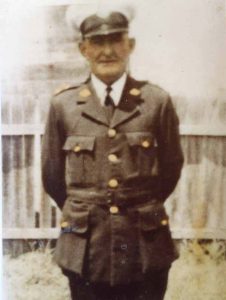
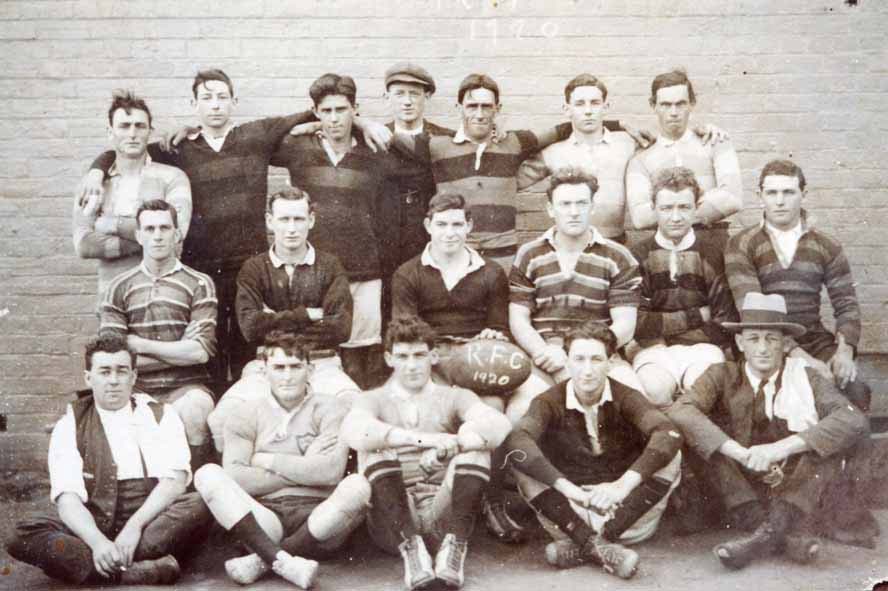
Basil Andrews was also made a Life Member of the Parramatta Junior League and later became the Penrith Junior Leagues first Life Member; a just reward for the many hours he spent working for the Junior Leagues in the district. Charlie Harris, after many years service to the Riverstone Club and to the Penrith J.R.L. was another who rewarded with Life Membership of both organisations.
Wally Brown was another interesting Riverstone personality who played for the club in the 1940’s. Wally owned a pig farm at Rouse Hill and always ran to training and back home again in his army boots, 7 km each way.
One of the Butcher’s most colourful supporter was a Mrs. Britton, an elderly lady who always sat in the same spot on the sidelines at the Riverstone games. Mrs. Britton was regarded as a health hazard to the opposition players. She often used her umbrella to trip players running up the sideline and several times clobbered them with the brolly.
The history of Riverstone Rugby league Football club is continued in the post 1945 history document.
